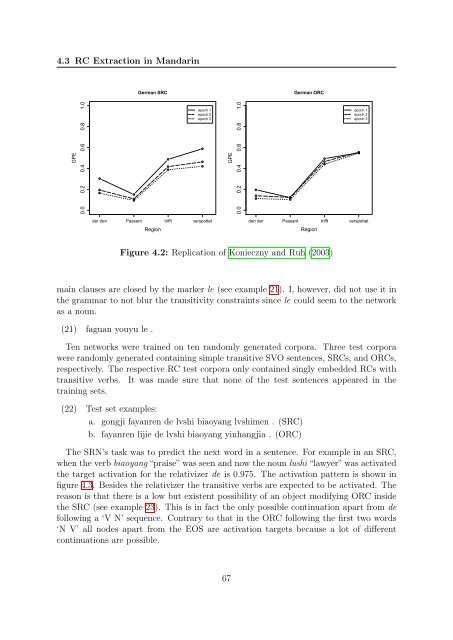Connectionist Modeling of Experience-based Effects in Sentence ...
Connectionist Modeling of Experience-based Effects in Sentence ...
Connectionist Modeling of Experience-based Effects in Sentence ...
Create successful ePaper yourself
Turn your PDF publications into a flip-book with our unique Google optimized e-Paper software.
4.3 RC Extraction <strong>in</strong> Mandar<strong>in</strong><br />
GPE<br />
0.0 0.2 0.4 0.6 0.8 1.0<br />
German SRC<br />
der den Passant trifft verspottet<br />
Region<br />
epoch 1<br />
epoch 2<br />
epoch 3<br />
GPE<br />
0.0 0.2 0.4 0.6 0.8 1.0<br />
German ORC<br />
den der Passant trifft verspottet<br />
Region<br />
Figure 4.2: Replication <strong>of</strong> Konieczny and Ruh (2003)<br />
ma<strong>in</strong> clauses are closed by the marker le (see example 21). I, however, did not use it <strong>in</strong><br />
the grammar to not blur the transitivity constra<strong>in</strong>ts s<strong>in</strong>ce le could seem to the network<br />
as a noun.<br />
(21) faguan youyu le .<br />
Ten networks were tra<strong>in</strong>ed on ten randomly generated corpora. Three test corpora<br />
were randomly generated conta<strong>in</strong><strong>in</strong>g simple transitive SVO sentences, SRCs, and ORCs,<br />
respectively. The respective RC test corpora only conta<strong>in</strong>ed s<strong>in</strong>gly embedded RCs with<br />
transitive verbs. It was made sure that none <strong>of</strong> the test sentences appeared <strong>in</strong> the<br />
tra<strong>in</strong><strong>in</strong>g sets.<br />
(22) Test set examples:<br />
a. gongji fayanren de lvshi biaoyang lvshimen . (SRC)<br />
b. fayanren lijie de lvshi biaoyang y<strong>in</strong>hangjia . (ORC)<br />
The SRN’s task was to predict the next word <strong>in</strong> a sentence. For example <strong>in</strong> an SRC,<br />
when the verb biaoyang “praise” was seen and now the noun lushi “lawyer” was activated<br />
the target activation for the relativizer de is 0.975. The activation pattern is shown <strong>in</strong><br />
figure 4.3. Besides the relativizer the transitive verbs are expected to be activated. The<br />
reason is that there is a low but existent possibility <strong>of</strong> an object modify<strong>in</strong>g ORC <strong>in</strong>side<br />
the SRC (see example 23). This is <strong>in</strong> fact the only possible cont<strong>in</strong>uation apart from de<br />
follow<strong>in</strong>g a ‘V N’ sequence. Contrary to that <strong>in</strong> the ORC follow<strong>in</strong>g the first two words<br />
‘N V’ all nodes apart from the EOS are activation targets because a lot <strong>of</strong> different<br />
cont<strong>in</strong>uations are possible.<br />
67<br />
epoch 1<br />
epoch 2<br />
epoch 3
















